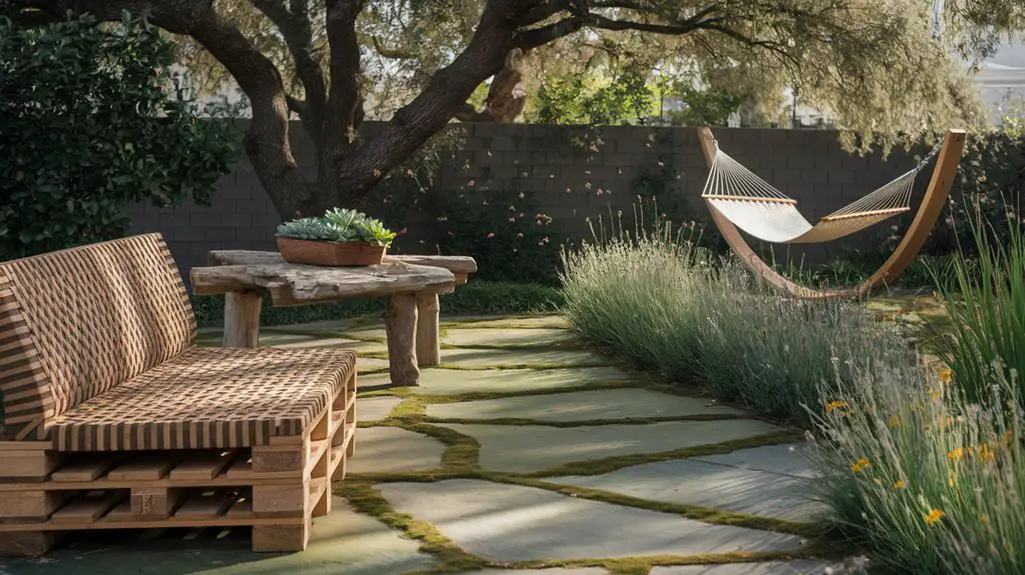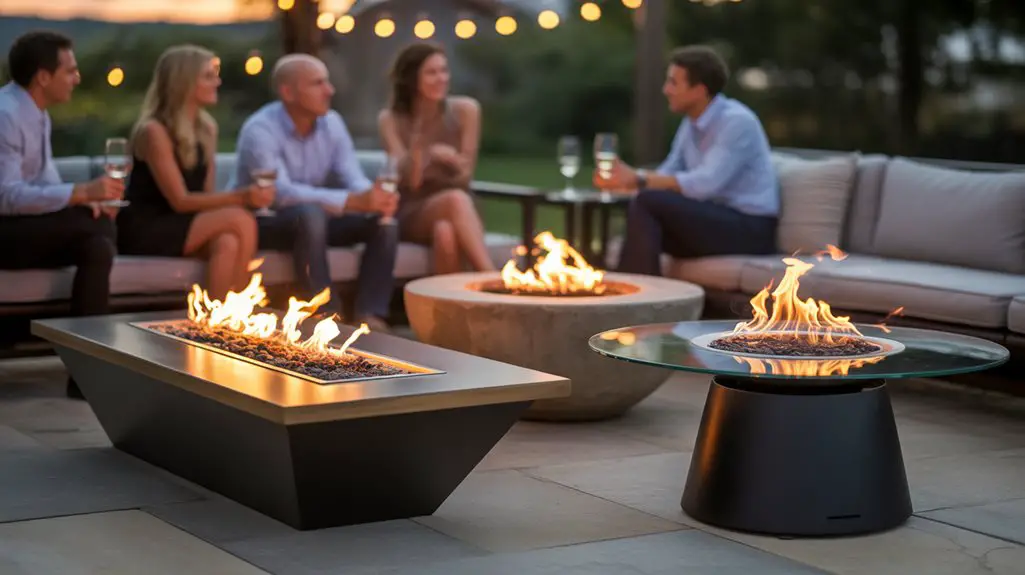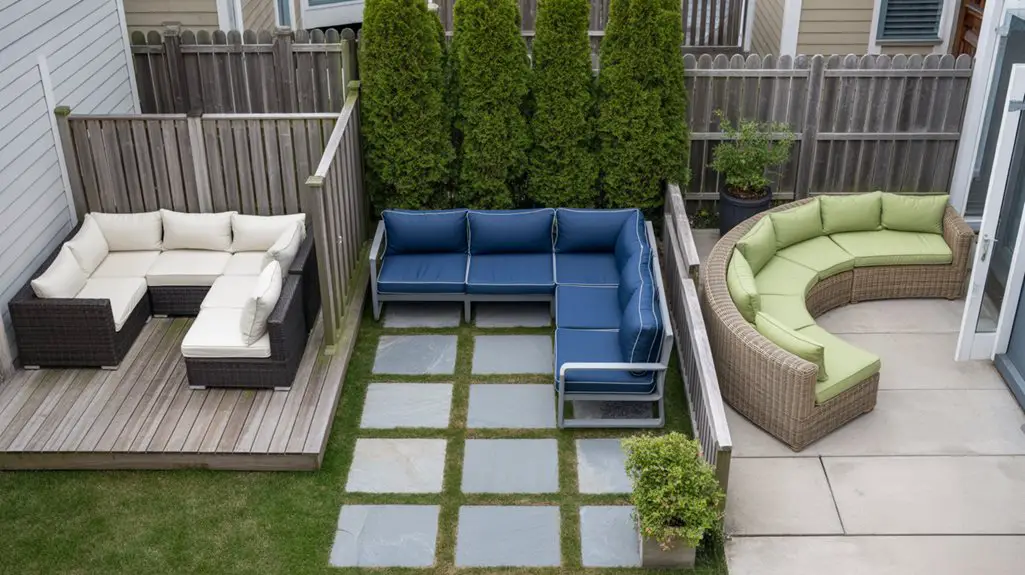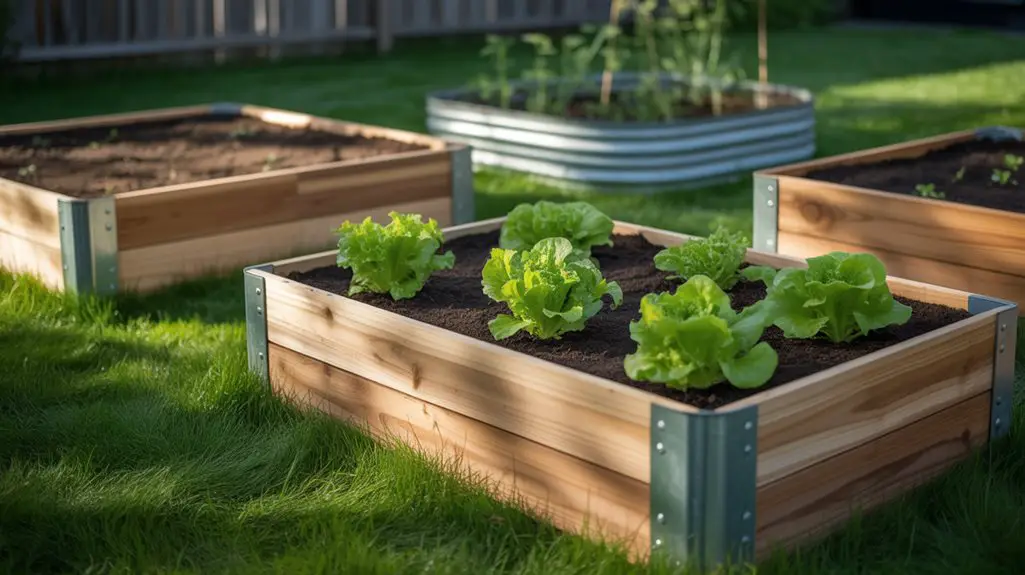Is sustainable furniture truly worth the investment for your backyard space? You’re not just buying a place to sit—you’re making an environmental statement that impacts deforestation, plastic waste, and chemical pollution. When you choose reclaimed wood over virgin timber or recycled plastic over new materials, you’re extending your eco-values into your outdoor living area. Your backyard can become a showcase for sustainability while providing the comfort and style you’ll enjoy for years.
Reclaimed Wood Patio Sets: Beauty With a Past
While many homeowners overlook the environmental impact of their outdoor furniture choices, reclaimed wood patio sets offer a sustainable alternative with unique character and durability.
These pieces transform timber from demolished structures, old barns, and industrial buildings into functional outdoor seating that prevents further deforestation.
You’ll find that reclaimed wood naturally resists weather damage due to its aged density and inherent oils. Each knot, weathered grain, and patina tells a story while providing exceptional structural integrity.
When sourcing, verify authenticity through documentation of wood origin.
Apply natural oils like tung or linseed bi-annually to maintain finish without harmful VOCs.
Contemporary designs now feature modular components with replaceable parts, extending furniture lifespan and reducing waste. Additionally, using renewable resources for backyard landscaping can further enhance the sustainability of your outdoor space.
Bamboo Outdoor Furniture: Renewable Elegance

Beyond the weathered charm of reclaimed wood lies another extraordinary material revolutionizing sustainable outdoor living. Bamboo outdoor furniture offers renewable elegance with remarkable environmental credentials. This fast-growing grass reaches maturity in just 3-5 years, compared to hardwoods that take decades, making it one of the planet’s most rapidly renewable resources.
You’ll find bamboo furniture delivers on both sustainability and performance:
- Tensile strength comparable to steel while maintaining lightweight construction
- Natural resistance to moisture, warping, and insects without chemical treatments
- Carbon-negative growth cycle that absorbs more CO₂ than is produced during harvesting
When selecting bamboo pieces, look for FSC certification ensuring responsible harvesting practices. Additionally, bamboo contributes to eco-friendly landscaping by helping improve soil health and preventing erosion.
Modern manufacturing techniques have transformed this traditional material into contemporary designs that withstand the elements while maintaining minimal ecological impact.
Recycled Plastic Adirondacks: From Bottles to Comfort

The transformation of discarded plastic bottles into durable Adirondack chairs represents one of sustainable furniture’s greatest success stories. Each chair typically repurposes 500+ plastic containers that would otherwise languish in landfills for centuries.
You’ll find these recycled pieces offer superior weather resistance compared to traditional wooden counterparts—no splitting, cracking, or annual refinishing required. The high-density polyethylene (HDPE) construction withstands UV exposure, salt air, and temperature fluctuations while maintaining structural integrity for 20+ years. Additionally, using low-impact materials in your backyard projects helps reduce your overall environmental footprint.
When purchasing, look for manufacturers who use 95%+ post-consumer plastic and low-emission production processes. Many companies now offer closed-loop programs where they’ll reclaim and recycle your furniture at the end of its lifecycle, creating a true circular economy solution for your outdoor seating needs.
Sustainably Harvested Teak: Responsible Luxury
Teak furniture, when responsibly sourced, combines unmatched natural durability with environmental stewardship. You’ll find properly harvested teak carries Forest Stewardship Council (FSC) certification, ensuring your purchase supports managed forests where replanting equals or exceeds harvesting rates.
The natural oils in teak create furniture that:
- Resists rot, insects, and weathering without chemical treatments
- Maintains structural integrity for decades, reducing replacement waste
- Develops a distinguished silver-gray patina that improves aesthetically with age
When shopping, verify chain-of-custody documentation that traces your furniture from forest to finished product.
Slow-growth teak (40-60 years to maturity) commands premium prices, but this investment directly supports sustainable forestry practices. Consider plantation-grown teak as an alternative to old-growth varieties for maximum environmental benefit. Additionally, choosing sustainable building materials for all your outdoor projects can further enhance your eco-conscious living efforts.
Upcycled Industrial Materials: Creative Seating Solutions
While premium teak represents one end of sustainable furniture options, repurposed industrial materials offer an equally eco-conscious alternative that dramatically reduces landfill waste.
You’ll find creative seating solutions in cable spools, shipping pallets, and steel drums—items destined for disposal before their transformation.
Pallets can be disassembled and reconstructed into modular benches or sectional sofas, while wire spools become striking coffee tables with minimal modification.
Consider concrete-filled tires as sturdy seating bases, topped with recycled fabric cushions for comfort.
For assembly, you’ll need basic tools: circular saws, cordless drills, and quality fasteners suitable for outdoor use.
Apply eco-friendly sealants to protect wooden elements from moisture damage. Additionally, incorporating backyard storage solutions can help maximize the functionality of your small outdoor area.
These upcycled pieces not only showcase environmental commitment but also introduce distinctive industrial aesthetics to your outdoor living space.
Hemp and Organic Cotton Cushions: Non-Toxic Comfort
Hemp and organic cotton blends offer superior durability while maintaining breathability and comfort even during hot summer days. These natural fibers provide significant environmental advantages:
- Hemp requires 50% less water than conventional cotton and grows without pesticides, making it an exceptionally sustainable choice for outdoor applications.
- Organic cotton eliminates the toxic chemicals found in conventional cushion covers, protecting both your family and local ecosystems.
- Both fibers are biodegradable, ensuring end-of-life disposal won’t contribute to landfill accumulation.
For maximum longevity, select cushions with removable, washable covers and water-resistant liners made from natural waxed fabrics instead of synthetic waterproofing treatments. Additionally, using reusable materials for your backyard events can further enhance your commitment to sustainability.
Solar-Powered Lighting Features for Eco-Friendly Furniture
As the sun sets on your sustainable backyard retreat, integrated solar-powered lighting transforms your eco-friendly furniture from daytime lounging spots into enchanting evening gathering spaces.
These systems harness daylight through small photovoltaic cells embedded in furniture frames, storing energy in efficient lithium-ion batteries.
Look for furniture with 3-watt LED strips that provide up to 8 hours of illumination on a full charge. Weather-resistant options with IP65 ratings guarantee durability against rain and humidity.
The most advanced designs incorporate motion sensors to conserve energy and dimmable settings for customized ambiance.
You’ll reduce your carbon footprint by eliminating the need for grid electricity while enhancing functionality.
Many models now feature USB ports to charge devices, making your outdoor space both sustainable and practical. Additionally, solar-powered lighting provides eco-friendly illumination that enhances both safety and aesthetics in your garden.
Biodegradable Furniture Options: Returning to Earth
When your outdoor furniture reaches the end of its useful life, biodegradable options guarantee it returns to the earth rather than languishing in landfills for centuries.
These innovative solutions decompose naturally through biological processes, completing the sustainable lifecycle.
You’ll find several biodegradable materials gaining popularity in eco-furniture design:
- Mycelium composite: Mushroom-based material that decomposes within 60-90 days, requiring only soil contact to initiate breakdown
- Hemp-based polymers: Offering durability during use but complete biodegradation within 2-3 years in commercial composting facilities
- Modified bamboo products: Treated with non-toxic, biodegradable resins that maintain structural integrity for 5-7 years but decompose naturally afterward
Maintaining Your Sustainable Furniture: Natural Care Techniques
Investing in sustainable furniture represents only half the journey toward an eco-conscious backyard. Proper maintenance extends your pieces’ lifespan, reducing consumption while preserving their natural beauty.
For wooden items, apply linseed or tung oil quarterly to nourish fibers and prevent moisture damage. Create a DIY cleaning solution using equal parts white vinegar and water with a tablespoon of lemon juice to remove grime without harsh chemicals.
Bamboo furniture benefits from coconut oil applications, while rattan pieces need humidity control to prevent cracking. Additionally, consider using eco-friendly fencing materials that complement your backyard aesthetic while enhancing sustainability.
For metal elements, remove rust with a paste of baking soda and water before protecting with beeswax. Store cushions made from organic materials in breathable cotton bags during off-seasons.
Conclusion
Your sustainable backyard oasis isn’t just about aesthetics—it’s a powerful environmental statement. By choosing reclaimed woods, renewable bamboo, or recycled plastics, you’re slashing your carbon footprint while creating a space that’s built to last. Don’t be a luddite about eco-materials; they’re technically superior to conventional options. Maintain your pieces with natural oils, and you’ll enjoy sustainable luxury for decades while protecting our planet’s precious resources.




